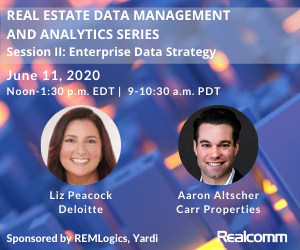How Coronavirus Could Spark the Modernization of Real Estate

As many office buildings sit at reduced or zero occupancy in reaction to COVID-19, owners, investors and onsite teams have had to quickly adapt to change. Some of commercial real estate’s technological flaws are being revealed as onsite teams run into limitations managing properties during such low occupancies.
With re-openings ahead, the new normal in office building occupancy could include deploying new health and safety measures, lease restructuring and negotiations, shifts toward multiuse spaces and unusual daily fluctuations in occupancy as companies explore remote work options versus renting an office space. These factors will directly impact how properties are managed and operated for years to come. But is CRE ready for this shift?
Many buildings in the U.S. were constructed before the end of the Cold War, with minimal updates to their HVAC and other systems since. A small fraction do not have any sort of building management system, and for a large fraction of the buildings that do, a lack of holistic and accurate data visibility exacerbated by proprietary communication protocols makes it difficult to quickly optimize buildings for new load regimes, much less implement adaptive control capabilities or take advantage of third-party services.
Thinking ahead
Portfolio managers, building owners and facility management teams alike are working to figure out how the future of work will impact their properties. How do we optimize systems when tenant needs will continue to shift? How do we protect against lower occupancy and potential loss of revenue? How do we ensure that changes in building operations actually make buildings safer? How can we maintain, or even improve, costs or the environmental footprint with new operating demands? These questions become even more significant when viewed across a real estate portfolio.
COVID-19 has made it obvious that large parts of CRE have fallen behind when it comes to technology, but whether this is a catalytic event and leads to the modernization of CRE remains to be seen. What’s clear is technology can not only enable operational optimizations, technological investments made now can also address many of the owner and investor concerns post-COVID that impact building value and can ensure CRE’s viability as a stable and profitable investment. For CRE to tackle digital transformation, as other industries have done, requires a mix of updated equipment, smarter control algorithms, and of course, data. Capturing the right data, analyzing data and most importantly, understanding the engineering behind the data to make it truly actionable. Having the right data can help address immediate issues, prevent future ones and help measure the impact of strategies.
First, take stock
Even the best control system will quickly become a virtual paperweight without the necessary data to drive it or when ladened with a bevy of deferred maintenance.
In our experience, the benefit of adding key data points usually justifies the physical costs and programming time. Points like occupancy, flow and real power can greatly expand the understanding of building loads and how to tailor operations. Within existing data points, operators should verify if the reported data point actually makes physical sense. While possible, it is highly unlikely that the mixed air temperature is going to be colder than the supply air temperature on a warm summer’s day.
This might also be a great time to address deferred maintenance. Those pesky costs that for either tenant improvement, lack of resource availability or fear of disruption have been passed from year to year. Backlogged work for motors, linkages/actuators or control systems are often the same root sources for energy efficiency opportunities.
Finally, in order to collect and take full advantage of the data available, facility managers need remotely accessible modern management systems that have the ability to pull data from various streams within a building. Access to accurate data and analytics on dynamic energy use and equipment performance provides critical information to optimize onsite operations.
Actionable data
Many onsite teams depend on once-a-month meter reads, utility bills or energy use intensities from basic software dashboards to provide information on energy use. While useful for general benchmarking, these static points fail to capture the causation of dynamic load shifts stemming from changes in occupancy or ambient conditions. They certainly cannot explain why a bill is suddenly and permanently higher, rendering their value minimal when it comes to truly understanding and optimizing building operations.
To be truly actionable, data often needs to be continuous and granular, penetrating far deeper than the utility meter, and usually must capture a variety of ambient and occupancy regimes. To find targeted opportunities for improvement, data must usually be available at the equipment and component level. Unfortunately, because of the ripple effect of buildings, this also usually requires collecting data from all of the interconnected systems since maximizing a system in isolation can negatively affect the performance of others.
The right holistic dataset can uncover even slight adjustments to equipment that add up to significant savings in energy costs once aggregated across many systems. However, ingesting, parsing and analyzing these enormous datasets goes far beyond spreadsheets, and indeed most building management systems today. Further, given the complications of changing weather patterns, dynamic building occupancy and complex utility pricing, the actual financial benefit often requires a robust platform capable of machine learning and long-term forecasting.
Data-backed investment ROI
COVID-19 and the likely impending recession means cost cutting is a top priority, but even in normal circumstances when cost-reducing investments must be justified, this exercise may become strenuous as tenants’ needs stretch building demands. Before the pandemic, CRE investors and owners already struggled to data-back energy efficiency investments to demonstrate real cost savings. With even tighter margins to work with, tracking a deeper set of data across operations can provide measurable proof of ROI or signal when strategies must pivot. Having data-backed investments can help properties differentiate among competitors for investors or tenants looking for more sustainable CRE options.
Inaccurate, unstructured and minimal unconnected data isolated in disparate systems will leave the commercial real estate industry stagnant and ill equipped to quickly adapt to changing conditions. However, there is now an opportunity to accelerate modernization to meet the pace of global business. As every business evaluates strategies set before COVID (and without the focus on daily tenant demands), now is the time for CRE owners, investors and operators to also evaluate the technology, equipment and vendors that best align for immediate and future success. With the right set of up-to-date, standardized data, property owners can identify energy inefficiencies, realize deeper energy savings and be more prepared to withstand future disruptions - whether natural disasters or economic uncertainty.
COVID-19’s impact will continue in CRE for some time. It's times like these that also offer an opportunity to reset for the future. With data at the heart of CRE’s modernization, owners and investors can gain the necessary edge to successfully navigate immediate cost cutting needs. More importantly, investments in technology will lay the foundation for a more strategic, optimized approach to portfolio management that continues to deliver financial, environmental and operational value for the long run.
This Week’s Sponsor
Yardi® develops and supports industry-leading investment and property management software for all types and sizes of real estate companies. Established in 1984, Yardi is based in Santa Barbara, Calif., and serves clients worldwide. For more information on how Yardi is Energized for Tomorrow, visit www.yardi.com.
Read Next
 5/29/2025
5/29/2025
AI Can’t Fix Bad Data. These Ideas Can Get You on the Right Track. Real estate visionaries constantly integrate innovative technology to make their organizations more efficient.
 5/22/2025
5/22/2025
Managing Building Automation and Integration Like an Investment Portfolio What if your building automation and integration decisions were managed with the same precision, discipline, and long-term vision as Warren Buffett’s investment portfolio?
 5/15/2025
5/15/2025
Tech, Talent and Transformation: 2025 Digie Finalists Announced For 27 years, Realcomm has presented the Digie Awards to acknowledge companies, real estate projects, technologies, and individuals that have advanced the commercial real estate industry through the strategic use of technology, automation, and innovation.
 5/15/2025
5/15/2025
Empowering Space Management with Data-Driven Visualization For effective CRE space management, it’s critical to centralize lease data, maximize rental square footage (RSF), improve energy efficiency and reconfigure spaces to meet changing needs.





%20(1)%20(1)%20(1).png)




.gif)




